The launch of a new product or feature is a stressful time for a company, particularly for Product Managers and Product Marketing Managers. You want a successful launch that acts as a springboard for new deals and helps the sales team move leads into the pipeline. For that to happen, your team needs to decide which strategies to execute and which to ditch.
How to create an effective product launch plan? We’re about to walk you through the actionable steps that will help you prepare for the launch and keep your whole team on the same page.
Start with customer research – ask your existing users or potential customers for their feedback. Understand their needs and pain points before you go into planning a launch strategy.
Create actionable goals for your product launch. Instead of focusing on one end goal, break it into smaller goals for each phase.
Visualize your product launch on a timeline. Depending on the scope of your launch, you can prepare customer journey maps, product roadmap, launch plan or a roadmap, and more assets as needed. See the examples and templates below 👇
Define roles and responsibilities for everyone on your team, and keep communication clear across teams within your org.
Use a product launch checklist to break bigger tasks into actionable steps and make sure all relevant steps are covered.
Keep your launch plan flexible to be able to quickly address all the changes along the way, especially if you work in an agile environment.
What is a product launch plan all about?
A product launch plan is a document that details the tasks and timelines behind getting users to interact with your new product or a new feature. It is an essential part of any marketing strategy behind a new product.
Creating a solid product launch plan will make it easier to identify your goals, set out your strategy, and designate tasks for different teams and members. It sounds like this one document has a lot to cover, but with a good online roadmap maker, you can design a roadmap that will help you implement your launch strategy and get your whole organization aligned around a single source of truth.
10 tactics to create the product launch plan that your new release deserves
When in the planning process for your next product launch, you need to ensure that all bases are covered. Start from customer and UX research then progress steadily through all other key actions, like adding milestones and checklists. Here are our top tips for product management team success with their product launch plans.
1. Start with customer research
Your product roadmap is focused on a specific goal: the launch of your product. But getting there requires high-level feedback from the target audience of your launch, and the chief among them are your customers.
Though this may seem like a labor-intensive task, product launches will not be complete without asking your customers for their thoughts on product features you have produced so far, and what they wish you would do differently.
Here at Chameleon, we add beta users of new products and features to our Slack channels to have a direct line of communication for support, bug hunting, and—as a great end result—improving feature adoption among beta users.
👉 Check out this interactive demo to explore how Chameleon Microsurveys help streamline in-app feedback.
Have you had customers who weren’t happy with how a product worked? Find out before creating your roadmap. Applying firmographic segmentation strategies to shape your ideal customer profiles and knowing what makes customers happy will help you map out the customer journey, organize your launch, and streamline the further development of your product.
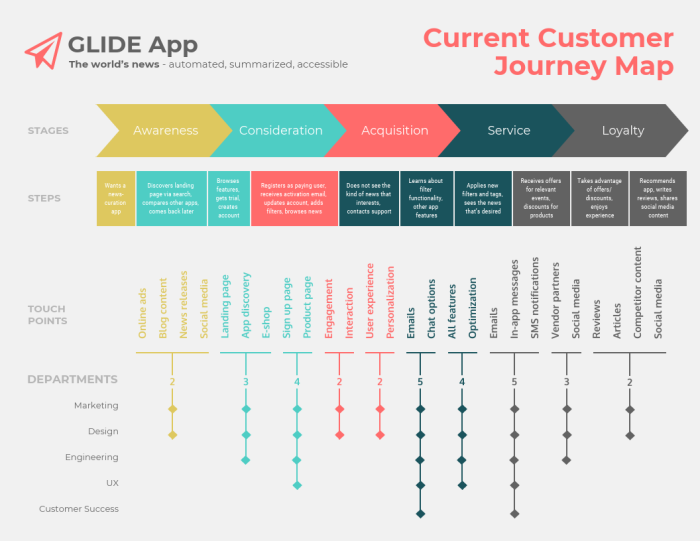
The above example of a customer journey map outlines what the process for customers is now and how it can be changed in the future. A chart like this could be the starting point for creating a plan for your new product launch.
Depending on your customer journeys, you can decide the scope of your launch and iterate your product roadmap. Also, don't forget to validate it with your users first.

🎬 Webinar: Validating Product Roadmaps With Your Users
Learn how to validate new product ideas and solutions with user feedback in this webinar with Maze
2. Create actionable product launch goals
With customer research complete, you also need to think about what kinds of goals you have to outline to complete your product launch formula. But, more importantly, you need to decide what does and doesn’t impact your overall goal.
💡 Take a look at the series of best practices on how to announce a new feature, along with a specific framework to make this section even easier.
A little bit of analysis is needed for this phase of your roadmap. Dive into your product analytics to find which product goals, marketing goals, and sales goals to achieve. Then, list out the key performance indicators (KPIs) for each goal. What resources do you need, and how much effort and man-hours are required?
Once you have the answers to these questions, then understand what launch activities you have to undertake to achieve your goals.
3. Organize your product roadmap template
Using a roadmap template can help you visualize your product strategy and save time. For example, you can start with Roadmunk's roadmap templates with a swimlane or a timeline view.
Once you have chosen a roadmap format that suits your needs, you can add your brand identity. According to the latest branding statistics, high-level branding is a necessity for both external and internal company communications. And, it's particularly important for launches since they often involve both employees and customers.
With your branding in place, you should be looking at choosing a select set of icons as a visual reference in your launch roadmap. Icons are a simple, yet poignant tool for sharing and organizing information effectively. Icons also remove the need for adding long paragraphs to explain a subject, as you can see in the example below.
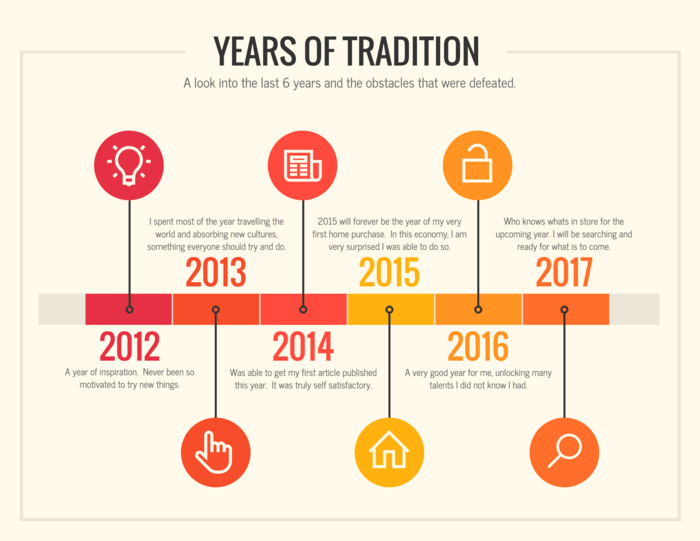
4. Expand your roadmap color palette
Visuals like icons help better with recall, as do colors. Using a set of contrasting colors in your roadmap will make information stand out and lead to people remembering points better. Using a unique color palette is also an effective way to add personality to your brand. You can also use colors to demarcate sections or phases of the product launch. This will make it easier for your team members to access the section most relevant to them.
Alongside a varied color palette, you should also use shades of colors, especially if you only have access to a limited color palette. You can see in the roadmap below how shades of a single color have been used to create sections.
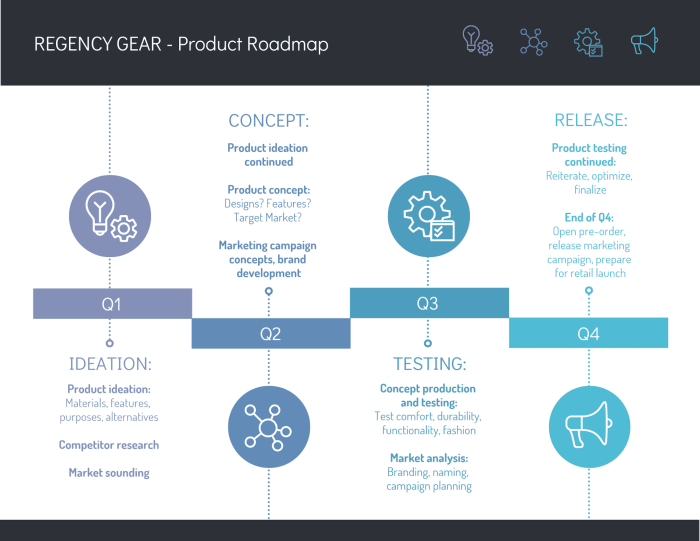
By using shades of the same color, you can expand the number of colors you can use, while still remaining minimalist.
5. Create a product launch plan index
An index provides a brief description of what your plan is all about and which ideas you are looking to implement. It also outlines the various phases of the launch. You can choose to show this in a variety of ways: as a standard index, a timeline, a mind map, a graph, or a table.
For anyone reading your plan, an index will ease them into the project and give them the lay of the land before they begin working.
6. Add milestone highlights
A product roadmap, especially one for a significant new product or feature launch, is likely to cover a lot of information no matter which roadmap format your choose. If you want to hold your teammates' attention, make sure the document is skimmable.
The modern human is increasingly busier and more overloaded with information than ever, and our attention spans have decreased as a result. We're used to skimming over headlines in our social media feeds, and quickly scanning through any articles we do click on.
Add visual hierarchy to your roadmap by pinpointing the salient points you need team members to focus on and highlighting them. You can achieve this in a number of ways - you can use bold or italics, break sections down to include more subheadings, or underline key phrases so they are immediately noticeable, as you can see in the example below.
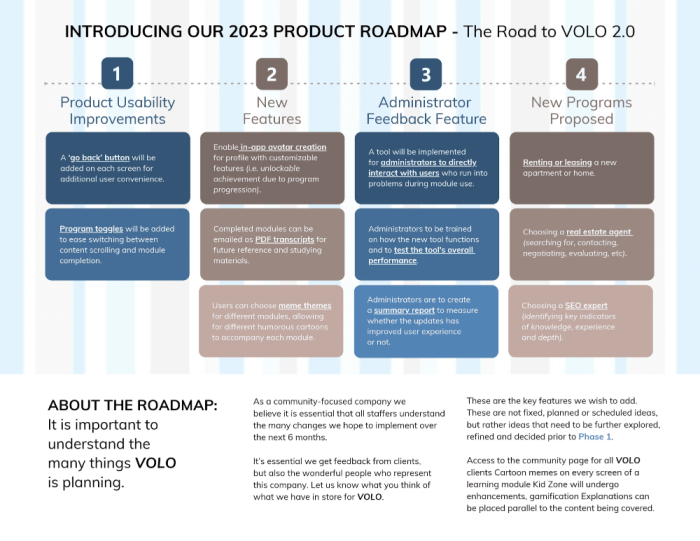
What you will also have noticed is that these highlights don’t only extend to headings or subheadings; you could emphasize different words and phrases within the body text of your product roadmap. This will ensure that your teammates know exactly what is the most pertinent information they need to get from that section.
7. Add calls to action
Product roadmaps have sections that are relevant to some staff members, but not others. But you don’t want the team members who aren’t involved in every step of the product launch to miss key deadlines or deliverables, which is why you need to include calls to action across your roadmap.
Instead of focusing on one end goal—the launch of the actual product—break down your phases into smaller goals and include a call to action for each of them.
For every phase of the project, include a section about what needs to be achieved or produced by the end of it. Use the aforementioned ways of highlighting text to make this call to action stand out to the reader.
Including calls to action, every step of the way will make the end goal feel more achievable, while also making your roadmap relevant to those who may not be involved in every aspect of the new product launch.
8. Visualize your product launch timelines
A great way to structure your roadmap is by creating a timeline. Using a simple timeline maker tool or taking advantage of timeline infographic templates, you can design a timeline that shows every step of your product launch with the amount of time required for each phase. You can also include what needs to be achieved within each phase.
You can see in this timeline roadmap below how each step towards the goal has been clearly outlined.
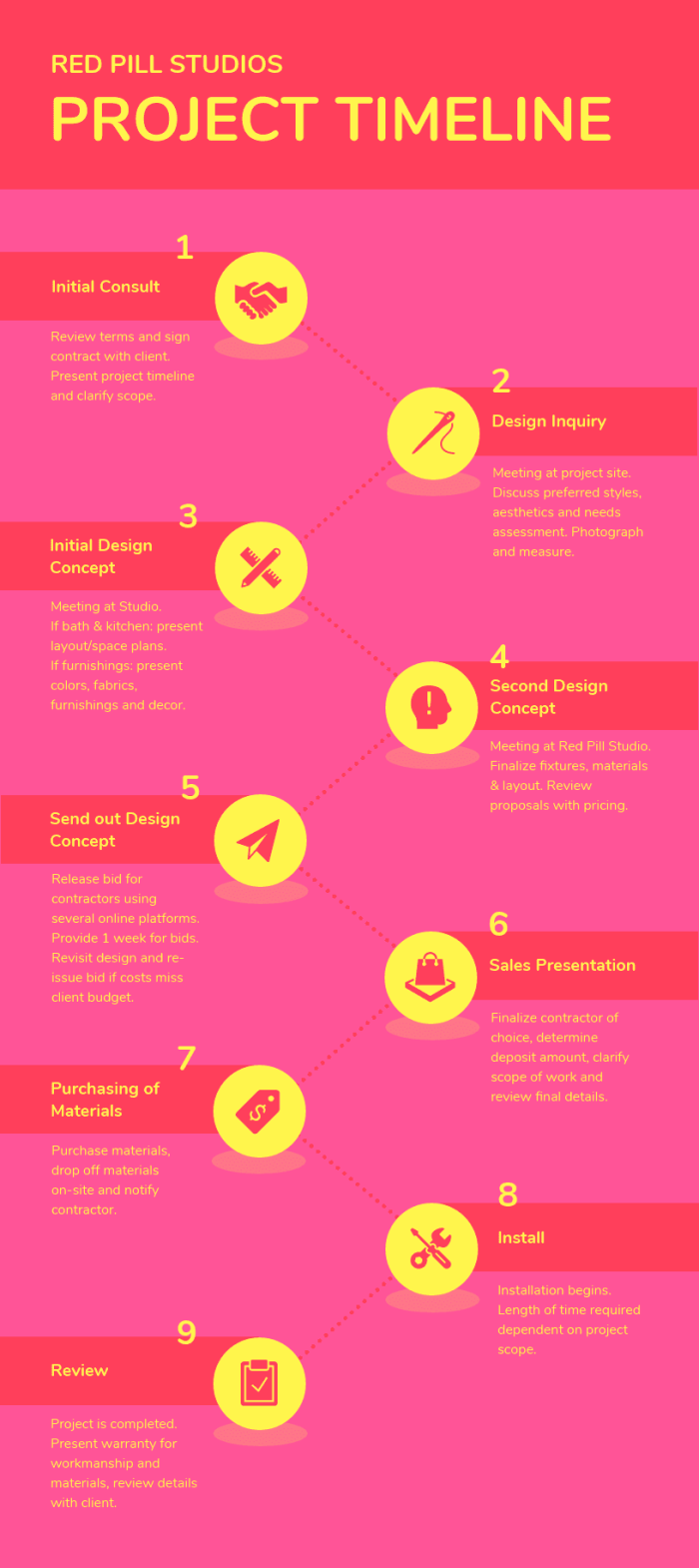
A timeline is a great way to show a project at a high level so everyone has a clear understanding of what needs to be achieved and by when.
9. Use a checklist
Aside from timelines, checklists are also one of the great product management tools to use in your product roadmap planning. Checklists break down a massive project, like a product launch, into smaller actionable tasks that can be achieved and marked off when completed.
This will help you ensure none of the important steps are missed. For example, as you prepare for your new product release, make sure that your Product Marketers are working along to prepare product announcements for different channels, including emails, blog posts, and in-app messages.
A checklist will require some work to create as it needs bigger goals to be broken down into its minutest components. But once that part is decided, the checklist will make it so much easier for everyone involved in the project to manage their workload.
Look at this checklist below which breaks down a marketing campaign into smaller, achievable tasks.
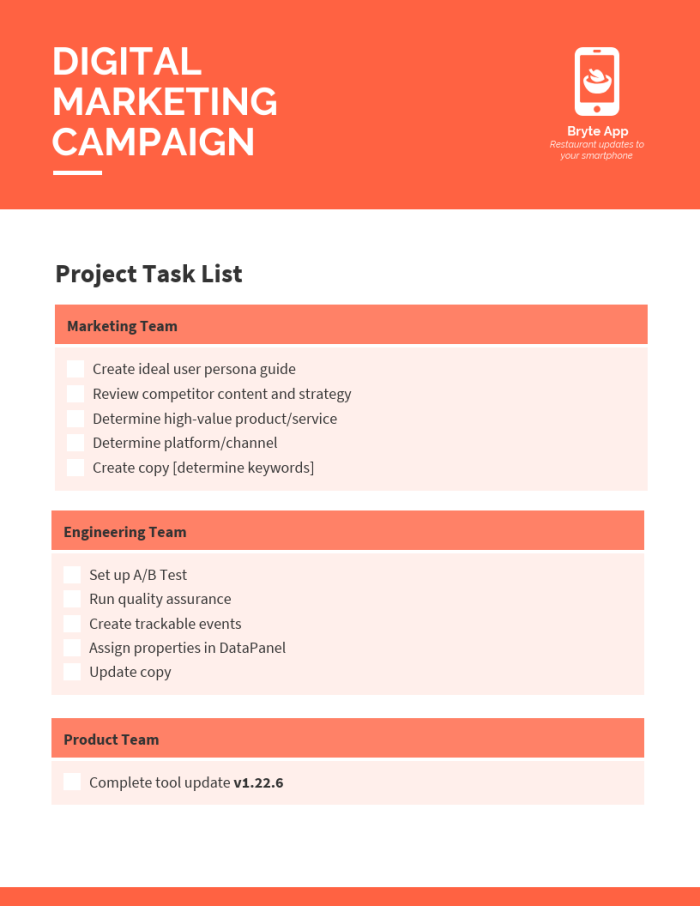
Checklists also make the Product Manager’s job better; they will no longer need to keep following up with colleagues about whether or not tasks have been completed. A quick glance at the checklist will tell you everything you need to know, so you can move on to the next task. Using a specialized tool like ProductPlan also makes sharing a roadmap overview an easy task.
10. Include dates to be updated
A project as big as a product launch will require many hands to be involved from different departments. Not everyone will be privy to changes or updates made to the plan—and we all know that plans are constantly subject to change. You don’t want someone to be working off of redundant information, but you can hardly email every single person about every slight change on your way to the big launch date.
This is why a successful product launch roadmap needs to have a section that includes the date it was last updated. This doesn’t need to be overly large or interfere with your design. You can choose to tuck it away in a corner—but make it visible enough that everyone can easily notice it when they look at the roadmap. And, of course, keep your roadmap flexible to be able to quickly address all the changes along the way, especially if you work in an agile environment.
Also, the important thing to remember is that everyone is looking to this one document for their workflow so they need to know when things have changed. A key aspect of product management skills is ensuring that everyone is on board and in the know at all times.
Adding a small note about the date it was last updated will make it easier for everyone to work, and save you the hassle of coordinating endless email exchanges. This will also help you manage your product launch email campaign.
Wrapping up product launch planning
With a few key tactics, you can create a product launch plan that is succinct, informative, and goal-oriented.
You need to do a little bit of research, make sure that your roadmap is easy to skim through without losing out on the salient features of the project, and keep in mind that the ever-changing nature of a live project needs to be reflected.
Incorporate the building blocks of your plan into a roadmap for a successful product launch. And don't forget to prepare positioning messages and in-app messages that will help your users realize the value of your new product quickly.

Boost product adoption with in-app messaging
Get started free with Chameleon and harness the power of product tours, tooltips, checklists, and surveys.
This article is written by Ronita Mohan, content marketer at Venngage, the online infographic and design platform. Ronita specializes in writing about visual content, online engagement, and digital marketing. All images in the article are sourced from Venngage.




